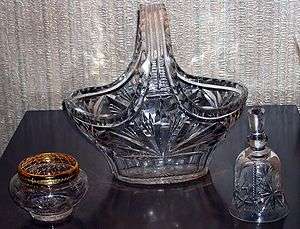Edinburgh Crystal

Edinburgh Crystal was a cut glass crystal manufactured in Scotland between 1867 and 2006, and was also the name of the manufacturing company. In addition to drinking glasses, Edinburgh Crystal made decanters, bowls, baskets, and bells, in several ranges. The company produced the glass panels for the lamps on the royal carriages.[1]
The Edinburgh Crystal company went into administration in 2006 and following its subsequent acquisition by Waterford Wedgwood, it became solely a brand name.
Ranges
There were many ranges of glassware but at the collectable end there were just four in the former 'Connoisseur Collection'.[2]
- 'Star of Edinburgh' – decorated with a star-burst pattern.
- 'Thistle' – the tops of these pieces are shaped in accordance with the thistle theme while the body is stippled.
- 'King James' – glassware in this range is notable for the long stems and neck, and is loosely based on that in use in the 17th century.
- 'Lochnagar' – Lochnagar was introduced during the reign of Queen Victoria and can be identified by its swirling pattern.
Collaboration by design
For several years students from Wolverhampton University and the Edinburgh College of Art were employed, for periods of 12–15 months, to work in the design department. This provided the students with work experience while inputting new design ideas. The 'Edge' range came out of this collaboration.
Visitor centre
This visitor centre, now closed, hosted around 100,000 people, each year, who came to Penicuik to see how the glass was made. It was situated off the A701 in Penicuik; OS ref: NT 239608.[3]
History
Glass container manufacturing can be traced back for at least 400 years. However, it was only in the 19th century that commercial companies appeared on the scene.
Amongst them, in 1867, the Edinburgh and Leith Flint Glass Company was established. Alexander Dixson Jenkinson took over the business upon the death of his father in 1880. Alexander Jenkinson died in 1909 and the business was inherited by Stanley Noel Jenkinson.
1921 saw Thomas Webb and Sons Limited of Stourbridge, West Midlands, buy Edinburgh Crystal which continued to trade under its own name.
1955 brought a name change from the Edinburgh and Leith Flint Glass Company to The Edinburgh Crystal Glass Company.
Further corporate activity took place in 1964 when Crown House Limited acquired The Edinburgh Crystal Glass Company and Thomas Webb and Sons.
During 1969, there was a move to a site of over 7 acres (28,000 m2) in Penicuik (which means ‘hill of the cuckoo’), some 10 miles (16 km) from Edinburgh.
Then in 1971 Edinburgh Crystal and Thomas Webb merged with Dema Glass, another Crown House subsidiary. Thomas Webb and Sons and The Edinburgh Crystal Glass Company traded well resulting in 1987 in being incorporated into the Coloroll Group.
After Coloroll went bankrupt, Caledonia Investments, with the support of senior managers, led a buy-out of the Edinburgh Crystal Glass Company and the Thomas Webb and Sons brand in 1990. The new company moved all manufacturing and distribution to its site in Penicuik.[4]
In April 2004, Edinburgh Crystal bought Caithness Glass from the receivers Deloitte. Caithness are notable for paperweights and the trophy presented to the winner of the BBC's Mastermind programme.[5]
On 21 May 2006 the offices of the headquarters were burnt out.[6]
On 26 July 2006 the Edinburgh Crystal Glass Company Ltd went into administration. Its two subsidiaries, the Caithness Glass Company Ltd and Selkirk Glass Ltd, continued to trade.[7]
On 31 July 2006, 300 of Edinburgh Crystal's 450 workforce were made redundant.[8]
On 5 August 2006 Caithness Glass Company Ltd went into administration.[9]
On 10 August 2006 Selkirk Glass Ltd went into administration.[10] It ceased trading soon afterwards.
In 2007 Edinburgh Crystal was bought and relaunched by Waterford Wedgwood.[11] Today the company exists as a brand name only, with all of the manufacturing being carried out overseas.
The Caithness Glass arm of the business was purchased by Dartington Crystal and is still trading with paperweights still being hand crafted in Scotland.
See also
References
- ↑
- ↑
- ↑ County Hotel, Selkirk
- ↑
- ↑
- ↑
- ↑ "Edinburgh Crystal Glass in administration". Deloitte. 2006-07-26. Archived from the original on 2008-11-23.
- ↑
- ↑ "Perth Caithness glass jobs face axe", Aberdeen Press & Journal, 5 August 2006
- ↑ "Borders glass firm faces closure", BBC News, 11 August 2006
- ↑ "Edinburgh Crystal Acquired and Relaunched", Annual General Meeting 2007, Waterford Wedgwood
External links
- Official website
- Scotland's Glass information
- Scotland's Glass 400th anniversary 2010
- Caledonia Investments